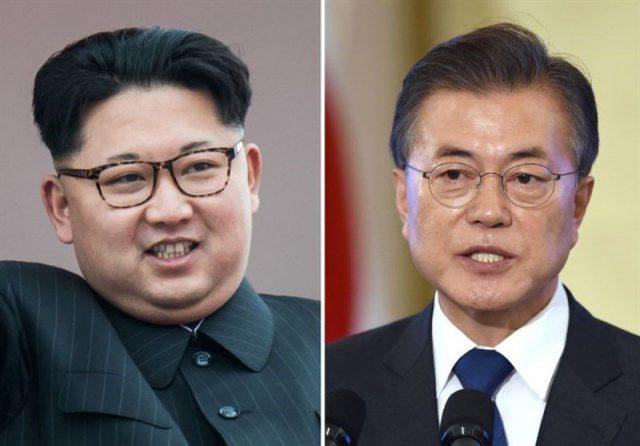
South Korean President Moon Jae‑in has just completed his first year in office, and what an eventful year it has been. Over the past 12 months, the world watched tensions surrounding Pyongyang’s nuclear weapon program take the Korean peninsula to the brink of war. And then, just as strikingly, we beheld a sharp de-escalation of those tensions, culminating in great strides toward inter-Korean reconciliation.
What explains this stunning turnaround? Did President Moon’s North Korea policy diverge drastically from that of his disgraced predecessor, Park Geun‑hye? Indeed, Moon had pledged to reverse many of Park’s policies in his electoral campaign.
In my new ASPI paper, Shifts in approaches to the DPRK under President Moon, I find that Moon’s North Korea policy has in fact been marked more by its continuity with that of Park than it has been by change—particularly in the defensive realm. The main element of change has occurred on the diplomatic front, where Moon’s engagement policy has facilitated the remarkable inter-Korean rapprochement of recent months.
Despite having reneged on a number of his electoral promises regarding Pyongyang, the overwhelming success of Moon’s diplomatic strategy has ensured that his approval ratings have remained exceedingly high—and now hover at around 85%.
In Moon’s electoral campaign, he promised a new approach to dealing with North Korea. Departing from Park’s stratagem of isolating Pyongyang, Moon harked back to the ‘Sunshine Policy’, emphasising dialogue and engagement. He pledged to reconsider the installation of the American Terminal High Altitude Missile Defense (THAAD) system—intended to intercept North Korean missiles—and expressed a will to pursue greater autonomy for South Korea within the confines of the US alliance. He also expressed a will to refrain from trilateral defence exercises with the US and Japan.
However, as North Korea’s nuclear and missile capabilities rapidly increased, Moon was steered down a more pragmatic and centrist policy line on all fronts except that of diplomatic engagement.
Indeed, Moon had every intention of eschewing the controversial THAAD anti-missile system. Yet as North Korea successfully launched successive intercontinental ballistic missiles (ICBMs) on 4 and 28 July—demonstrating a newly acquired capability to strike the US mainland—President Moon felt compelled to fully deploy and operationalise the system.
Although he stressed that this was a temporary arrangement, an announcement from the North a mere two months later served to consolidate the THAAD deployment: Pyongyang’s official mouthpiece—KCNA—reported that North Korea had successfully tested a hydrogen bomb intended to be mounted on an ICBM.
Moreover, despite Moon’s expressed desire to pursue greater independence for Seoul within the bounds of the US alliance, the North Korean nuclear problem necessitated a realignment in the alliance towards greater cooperation, rather than increased autonomy for Seoul. Moon had little option but to go into damage control on the alliance front and work to strengthen the US–South Korean bilateral defence posture.
Trump’s visit to Seoul in November 2017 provided an opportune forum for this realignment, with Moon expressing his support for the US‑led UN sanctions on Pyongyang, affirming that denuclearisation was the priority, and concurring that a combination of pressure and engagement was the best way to proceed. The Trump–Moon summit culminated in a joint statement emphasising the commitment of both countries to further squeeze Pyongyang, including the prospect of a new round of sanctions.
As a corollary of this realignment, under the Moon administration there has been a strengthening of trilateral defence cooperation between South Korea, Japan and their mutual ally, the US. This has occurred in spite of Moon taking a hardline stance against Tokyo during his presidential bid. As the threat emanating from North Korea continued to escalate following his election, Moon proceeded to enhance trilateral defence cooperation through intelligence sharing and joint military exercises. Those initiatives were aimed at improving the allies’ capacity to launch coordinated responses to Pyongyang’s provocations.
The element of Moon’s North Korea policy that has aligned most closely with his electoral campaign has been his openness to diplomatic engagement. Moon’s willingness to accept Kim Jong‑un’s proposal for joint participation in the Winter Olympics triggered a series of diplomatic advancements in Seoul–Pyongyang relations. That culminated in the mutual decision to convene an inter-Korean summit—the first in over a decade.
Seoul capitalised on that stunning diplomatic achievement to broker an agreement between Trump and Kim to conduct a US–North Korean summit, now scheduled to take place in Singapore on 12 June.
The main diplomatic challenge that lies ahead for Moon is ensuring that Trump’s North Korea policy remains in harmony with his own. While it’s feasible that Moon would concede to an incremental denuclearisation of the peninsula, Trump will likely be intent on securing short-term gains on this front. We can also expect that Trump would be more inclined to walk away from a denuclearisation deal with Pyongyang if the terms of the agreement are not implemented expediently.